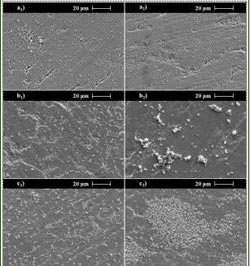Can silver promote the colonization of bacteria on medical devices?

Figure: SEM micrographs of S. epidermidis IE186 adhered to Ag-TiCN coatings after 2 h and 24 h period of contact: adhesion and biofilm formation to Ag/Ti = 0 a1) and a2) respectively; to Ag/Ti = 0.37 b1) and b2) respectively; to Ag/Ti = 0.62 c1) and c2) respectively. (C) I. Carvalho et al. Sci. <br>
Biomaterials are increasingly being used to replace human organs and tissues. Since biomaterials are susceptible to microbial colonization, silver is often added to reduce the adhesion of bacteria to biomaterials and prevent infections. However, a recent study by researchers in Portugal suggests that – in one material – increasing levels of silver may indirectly promote bacterial adhesion.
Published in the journal Science and Technology of Advanced Materials[1] (http://dx.doi.org/10.1088/1468-6996/14/3/035009), the study examined how surface properties affect the adhesion of Staphylococcus epidermidis bacteria to silver-titanium carbonitride (Ag-TiCN) coatings used for hip implant applications.
Normally found on human skin and mucous membranes, Staphyloccus epidermidis is one of the main pathogens associated with prosthetic device infections. A nanocomposite thin film, titanium carbonitride is non-toxic to human cells and features excellent wear resistance, high hardness and good corrosion resistance.
Previous studies have shown that the adhesion of bacteria to biomaterials can be affected by the surface properties of bacteria, the surface properties of the material, and environmental conditions. In this study, Isabel Carvalho and her colleagues found that as the silver content of Ag-TiCN films increased from 0 to 15 percent, the surface roughness of the films decreased from 39 nm to 7 nm, while the hydrophobicity of the surface increased.
In addition, the study found that surfaces that were less rough and more hydrophobic were associated with greater bacterial adhesion. This suggests that increasing levels of silver in Ag-TiCN thin films may promote bacterial adhesion via a hydrophobic effect.
References and related websites
For more information about this research, please contact:
[1] Isabel Carvalho, Mariana Henriques, João Carlos Oliveira, Cristiana Filipa Almeida Alves, Ana Paula Piedade and Sandra Carvalho: Science and Technology of Advanced Materials Vol. 14 (2013) p. 035009. DOI: 10.1088/1468-6996/14/3/035009
Corresponding author: Isabel Soares Carvalho
GRF-CFUM, University of Minho, Campus of Azurém, 4800-058 Guimarães, Portugal
Media contacts:
Mikiko Tanifuji
National Institute for Materials Science, Tsukuba, Japan
Email: stam_office@nims.go.jp
Tel. +81-(0)29-859-2494
Associated files available for download
View/download the file 'STAM-PressRelease2013Jun_Bacteria_DrCarvalho.pdf.
Journal information
[1] Isabel Carvalho, Mariana Henriques, João Carlos Oliveira, Cristiana Filipa Almeida Alves, Ana Paula Piedade and Sandra Carvalho: Science and Technology of Advanced Materials Vol. 14 (2013) p. 035009. DOI: 10.1088/1468-6996/14/3/035009
Media Contact
All latest news from the category: Materials Sciences
Materials management deals with the research, development, manufacturing and processing of raw and industrial materials. Key aspects here are biological and medical issues, which play an increasingly important role in this field.
innovations-report offers in-depth articles related to the development and application of materials and the structure and properties of new materials.
Newest articles

Recovering phosphorus from sewage sludge ash
Chemical and heat treatment of sewage sludge can recover phosphorus in a process that could help address the problem of diminishing supplies of phosphorus ores. Valuable supplies of phosphorus could…

Efficient, sustainable and cost-effective hybrid energy storage system for modern power grids
EU project HyFlow: Over three years of research, the consortium of the EU project HyFlow has successfully developed a highly efficient, sustainable, and cost-effective hybrid energy storage system (HESS) that…

After 25 years, researchers uncover genetic cause of rare neurological disease
Some families call it a trial of faith. Others just call it a curse. The progressive neurological disease known as spinocerebellar ataxia 4 (SCA4) is a rare condition, but its…





















